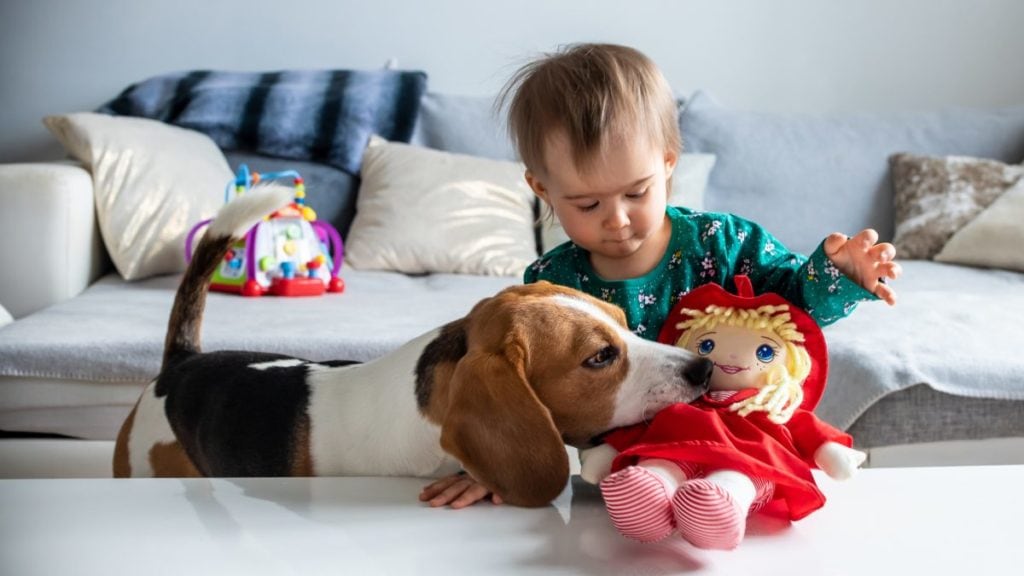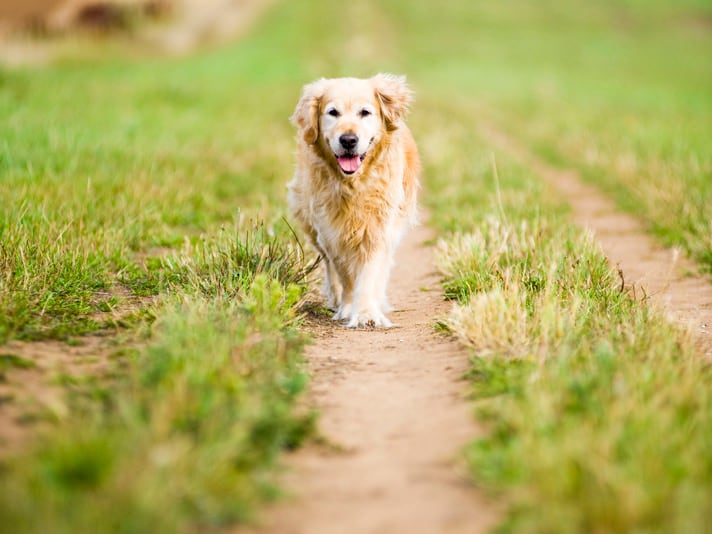It can be tough for a pet to tell the difference between dog toys and toys for kids. For one thing, many toys for kids look a lot like dog toys. Also, your child’s smell can make their toys especially interesting to your dog.
Proper dog training can teach your confused pooch to leave your kid’s toys alone. To train your dog not to play with toys for kids, you’ll need to make changes to your home environment and teach him which toys are his.
Manage the Environment
As mentioned in one of my previous articles, “Dog Behavior Management vs. Training,” management is crucial for changing a dog’s behavior. Dog behavior management entails changing the environment to help prevent your pet from engaging in the problem behavior.
In the case of toys for kids, management is usually the fastest and easiest way to prevent problems. In fact, it’s often the only thing you need to do.
To keep your dog away from your kid’s toys, put up a baby gate or an exercise pen, like the Frisco dog exercise pen with step-through door. This easily and effectively separates the dog’s area from the area your child plays in.
With the dog confined in his own space, and the toys for kids outside of that space, there is no way for your pet to reach them.
You also can do this in reverse (so to speak): Keep the toys for kids in a playpen that the dog can’t access. As long as you have a barrier, this will keep your child and dog from accessing each other’s toys. A bonus is that the barrier helps keep both safe when you cannot actively supervise their interactions.
Teach Your Dog Which Toys Are His
If you happen to have a new puppy or an adult dog who doesn’t have much experience with toys, you can start off on the right foot by teaching your dog that only the things you give him on cue are his toys. (It is more difficult to train dogs who are used to all the toys in the house being theirs, but you can use the same method to teach them as well.) Here’s how:
- Take a new dog toy, such as the Frisco Textured Plush squeaking monkey dog toy, and hold it in front of your dog.
- Tell your dog to sit.
- As soon as your dog sits, say “take it” and then hand the toy to your dog. If he hesitates, you can wiggle the dog toy around to encourage your pup to take it.
- When your dog takes the dog toy, praise him. Then spend a little time playing with him or let him play with the toy on his own for a while—whichever he prefers.
Once he’s mastered this, the next thing to teach your dog is when he can and cannot grab something. Over time, he will learn that if he doesn’t hear the words “take it,” then he should not take the item. Here are the steps:
- Put some treats in your pocket.
- Pick up something that is not a dog toy while your pup watches. The object can be anything—sunglasses, a book, etc.
- Tell your dog to sit.
- When he sits, praise him and feed him a treat. Then put away the object you were holding.
To help your dog clearly understand, alternate between the two training routines of offering your dog toy and not offering another object. Also, use different dog toys, so your pet understands that the key is the cue “take it,” not the specific toy. For example, you might practice one day with a Frisco skinny plush squeaking raccoon dog toy, the next day with a Frisco canvas no-squeak dino dog toy, and the day after that with a Frisco textured plush squeaking monkey dog toy.
Over time, use items your dog would find interesting in the non-dog-toy training. Work up to practicing with toys for kids.
Note: If at any point your dog tries to grab the non-dog-toy item you are holding, put it away and offer your pet a dog toy instead.
Additional Dog Training Tips
To help your dog learn the “take it” cue, keep all toys (including dog toys) out of reach except during practice times. You can make the rules even clearer if you only let your pooch have dog toys when he is in his exercise pen or another specific location.
Another way to help prevent confusion is to choose different types of toys for your child and your dog. For example, you might give the dog rope toys while the baby gets stuffed toys. If the dog toys don’t look, smell or feel like the toys for kids, it’s easier for your pet to tell which toys are dog toys.
It’s also important to teach your dog to drop items on cue, in case he does pick up the wrong toy. You can teach your dog to “drop it” using a dog clicker. Not comfortable using a dog clicker? Teach your dog to “drop it” with without using a clicker.
Most importantly, remember that if your dog does take one of your kid’s toys, he’s not doing it out of spite or to show dominance over your child. He’s just confused and thinks the toy is something he’s allowed to play with. Using the training steps above, you can help reduce the confusion; and a little management goes a long way.
Share:













